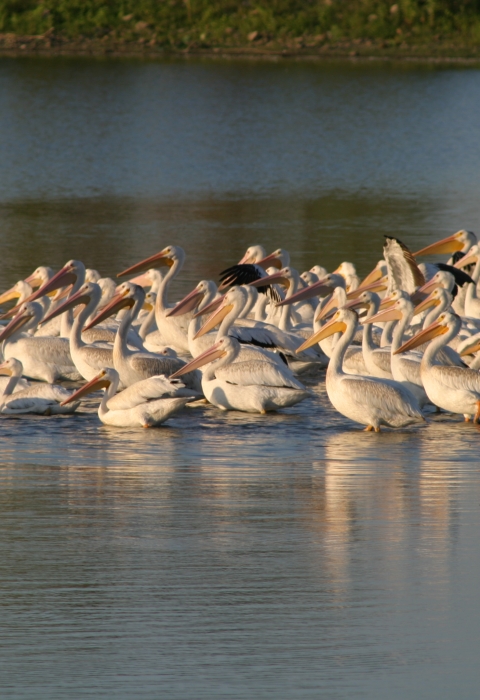Seasons of Wildlife
Winter
Starting in November, geese by the thousands arrive at the refuge from their northern breeding grounds. These winter “snowbird” residents feed on refuge-grown grain, which prepares them for spring migration to their summer breeding grounds. By late February, the winter wheat has all been eaten and the geese begin their journey north. Breeding season also begins for owls, hawks, and fox squirrels. Northern harriers and red-shoulder hawks soar low over farm fields in search of small mammals, and bald eagles are often spotted from Wildlife Drive or Bennett Lane, especially near Big Mineral Day Use Area. Visitors, too, flock to the refuge to observe waterfowl, photograph wildlife, hike, or fish.
Spring
In March, spring heralds the beginning of a significant transition period. As monarch butterflies begin arriving from Mexico on their northerly migration, thousands of migratory shorebirds stop over to feed in refuge wetlands. Migrating warblers, American white pelicans, hawks, and hummingbirds arrive, some stay to nest, while others pass through on their journey north. Bluebirds begin scouting for nesting cavities, and the song of dickcissels, meadowlarks, and colorful painted buntings again echo from fields and forests. Visitors enjoy the sights, smells, and sounds of spring including budding green trees, frog calls, and fragrant wildflowers. Fishing in Lake Texoma is usually excellent during this time and many anglers seek spawning crappie.
Summer
It’s nesting season and the refuge is abuzz with activity. Great blue herons roost in their treetop nests; fledgling chicks of bluebirds, dickcissels, painted buntings, and killdeer appear; and white-tailed deer fawns lie hidden in the grasslands. By August, shorebirds head south, but winter residents such as blue-winged and green-winged teal begin to arrive. Visitors seek relief from summer heat in shady refuge forests and enjoy boating and fishing on Lake Texoma. Wildlife-watching is at its best in prairie, forest, and open water habitats.
Fall
Autumn’s shorter daylight hours trigger migratory behavior in summer-resident birds, who depart for their tropical winter homes. As part of their own southward journeys, migratory shorebirds stop on the refuge to feed in the mudflats and rest. Visitors enjoy the memorable sights of migrating monarch butterflies, raptors, and thousands of white pelicans. Striped bass fishing is excellent on Lake Texoma, and bow hunters prepare for autumn deer season. Vibrant colors and invigorating smells fill the crisp autumn air.
Featured Species
Hagerman National Wildlife Refuge is well known for the diversity of migratory birds that can be found here. In all, 338 species have been spotted here so far. Thousands of waterfowl species use refuge impoundments, waters of Lake Texoma, and managed fields as stop-over and wintering grounds. Some featured species include pintails, mallards, and gadwalls, as well as snow, white-fronted, and Ross’ geese. Migratory shorebirds arrive by the thousands to feed in shallow marshes and along the Lake Texoma shoreline during spring and fall. Songbirds, including painted and indigo buntings, great crested and scissor-tailed flycatchers, and summer tanagers, nest here during spring and summer.
Although birds are often at the top of the list for visitors, they are definitely not the only attraction. Native prairie grasses and colorful wildflowers provide seasonal food and shelter for a host of wildlife. Butterflies, dragonflies, dickcissels, and meadowlarks flutter through the summer landscape. Bottomland hardwoods along creeks attract a variety of wildlife including bobcats, raccoons, mink, wild turkey, river otters, turtles, and fox squirrels. Owls and coyotes are often heard at dusk and white-tailed deer can be seen foraging in fields along Wildlife Drive.
